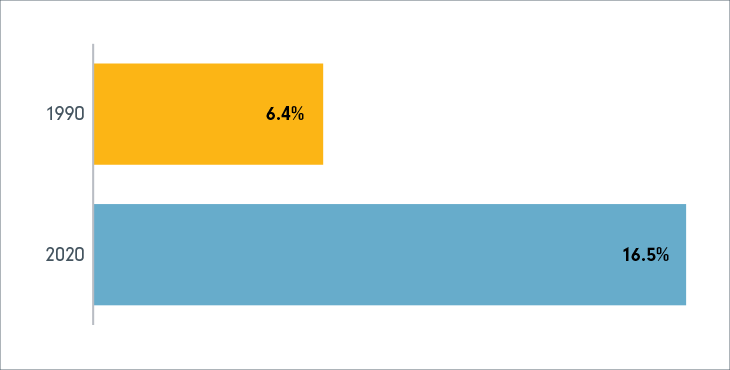
Feature artice from our U.S. partners
To assume that 2019-thinking is applicable to the challenges and opportunities that lie ahead is to ignore the extremity that was 2020.
Yet, as my colleagues and I talk to family office leaders and family members throughout the country, we are hearing conversations about the future that start with, “Now that we are getting back to normal….”
It is evident that we have changed, our employees and our families have changed, and the context in which we all operate has changed. These changes surely go deeper than the behavioural changes that may eventually snap back. Fundamental tweaks to who we are, how we see the world and how we engage have occurred as a result of the past year. These changes are capable of affecting the family system and how a family office solution serves the family. Ignoring them is, at best, a lost opportunity.
We understand there are many practical, tangible and pressing decisions that need to be made on behalf of the family and the office, and we’re not suggesting they be ignored. Rather, we are proposing that if we are truly committed to helping our families and employees thrive, we need to carve out some time to explore the personal impact of the past year.
The five questions below aren’t the most urgent, and many executives and family members will likely ignore them. But from my team’s perspective – after nearly two decades of working in the family office space and over a thousand conversations with family offices in the past year alone – they may well be the most timely and meaningful. Meaningful in that they can uncover unseen risk and opportunity to the family, they may have an oversized influence on the office’s ability to remain relevant to an evolving family, and they can help reclaim the vibrancy an office needs to serve the family the best it can. Timely in that we are at an inflection point right now; things are still in flux. How we respond – or not – at this moment can set the tone and direction for years or even generations to come.
- As wealth inequality skyrockets and animosity toward the ultra-wealthy grows, what risks and opportunities do these trends pose to offices and the families that you serve?
- How has the rising generation changed over the last twelve months (and what are you doing about it)?
- By “staying in our lane,” is the office missing opportunities to remain relevant?
- Your employees know what you did last summer. Do you double down or course-correct? Diversity and inclusion in the family office: Is it a movement or a moment?
- Diversity and inclusion in the family office: Is it a movement or a moment?
1. As wealth inequality increases and animosity toward the ultra-wealthy grows, what risks and opportunities do these trends pose to offices and the families that they serve?
Ratio of U.S. top 1% total net worth to bottom 50%

Source: Board of Governors of the Federal Reserve System (U.S.), total net worth statistics, retrieved from FRED, Federal Reserve Bank of St. Louis; https://fred.stlouisfed.org/series/WFRBLT01026, May 6, 2021.
The change in family wealth distribution over the past few decades is arresting, as illustrated in the chart above. At the beginning of 1990, the total net worth of the top 1% of families in the U.S. was 6.4 times that of the entire lowest 50%. But in early 2020, that number had increased to 16.5 times.1 The dichotomy between the “haves” and the “have nots” creates a dynamic where it’s easy for one side to harbour a healthy level of distrust and anger toward the other.
The animosity toward the ultra-wealthy has been simmering for quite some time, but has been brought to a boil recently as a result of the past year’s events. We have seen news coverage of rallies where protesters have spray painted “eat the rich” on the outside of buildings, and observed a growing “eat the rich” sentiment on many college campuses.
The increase in wealth disparity and the general sentiment toward the rich pose a risk that many offices aren’t thinking about. However, when I speak to family offices that are talking about this issue, they identify risks that fall mainly into two categories: outside risk and risk from within.
Outside risk
- Physical security – The greater the public visibility or vitriol regarding that issue of wealth inequality becomes, the greater the safety concern for the family. Executives may put constraints on family members moving freely or how they appear in public (or even try to meet in private). Protocol may include starting limited exposure of family members in public places, travelling with security or considering the safety implications of protests or social activism at family meetings or reunions. Kidnappings have always been a problem for our families. In looking at kidnapping rates outside the U.S., we’ve been relatively lucky – so far. But, as we know now, things can change in a moment’s notice.
- Loss of social licence to operate – From a public perspective, the ultra-affluent are currently allowed to move around freely, attend colleges openly and visibly lead their business ventures. But as negative sentiment toward the upper class increases, they may not be able to be as out-front with their ventures, because consumers won’t want to support them, or communities won’t want them operating in their backyards. “Of course, the pitchforks are coming,” remarked one family member. “It’s just a question of when.”
- Wealth confiscation – When politicians choose their battles over taxation, might public opinion of the ultra-wealthy influence their targets? Beyond legal taxation, theft through cyber fraud challenges family offices daily. More dramatically, if we look back through history, extreme wealth redistribution is often tied to violent uprising and state collapse, as Walter Scheidel’s The Great Leveler details.
- Diminished talent pool to draw from – Bringing it back home to something simple: If there is growing animosity toward the rich and talented professionals who don’t want to be perceived as part of “the problem” or seen as part of the “wealth defence industry” to use a term coined by Chuck Collins, author and director at the Institute for Policy Studies, family offices could face a shortage of top talent, or attract professionals who may not truly be committed to the success of the family.
While the outside risks are real, they can feel less urgent and more immovable. What can one family do? The risks from within may pose a potentially more immediate and disruptive threat that can feel more tangible in families today. In our observation, this is perhaps the biggest shift we’ve seen over the past year, because our clientele can’t look past the gross inequity between how they and most other Americans have weathered the past year.
Risks from within
- Disowning wealth or desiring to “tear down capitalism” – There are family members who are interested in actively disowning their wealth as a result of the perceived systemic issues associated with the ultra-wealthy. A lot of millennial family members seem to be more active in their separation from the family’s wealth in order to “live their values,” a trend so noticeable it was even captured in The New York Times.2
- Apathy toward the enterprise – Even if members of the family aren’t going as far as to completely separate themselves from their wealth, we are seeing more general apathy toward the family enterprise, which can be just as destructive over time as active disengagement. Again, the younger generation (more often, but certainly not exclusively) feels as though something’s off, that they may be part of a “bad system.” While they may not be those who are going to raise their hands, ask questions and try to tear the system down, they have no desire to have an active involvement in the family.
- Loss of respect and/or relationships with other family members – A lot of the conflict and polarization within families is leading to damaged relationships through the loss of respect for other family members. It’s not healthy for the family system, not healthy for oneself and certainly not healthy for keeping the family enterprises successful.
Preparing for or mitigating these risks is important. So the all-important question: How do we do that? And where might we be able to flip that risk mitigation as a positive opportunity for the family?
Some of the families we’ve talked to are trying to address these risks through efforts such as revisiting the family’s vision, working with greater intentionality to lead in their communities or working on engagement with the rising generation.
Now may be the right time for families to reset their vision of success, come together and redefine how they want to show up as a family.
Questions for reflection
- What risks and opportunities do these trends, unchecked, pose to offices and the families that they serve? And over what time horizon?
- How have peer families responded to or been affected by inequality in past generations?
- Have we set aside time for families to reset their vision of success?
- What is our role as professionals or family leaders in starting conversations others might not want to have?
- How do we as professionals reconcile our role in a system we may simultaneously benefit from and find fault in?
2. How has the rising generation changed over the last twelve months (and what are you doing about it)?
Let’s think about how that rising generation has changed over the last 12 months.
The events of the last year have made a lasting impression on everyone, and the rising generation is no exception.
Overall, we saw some positive changes in the ways in which generations evolved their engagement with one another over the past year (most notably, in the early stages of the pandemic, starting with lockdowns). Perhaps due to the forced intimacy of close confinement, we observed increased quality time and peership across generations, which led to greater transparency and engagement between generations.
The pandemic allowed many parents to see their kids more like peers with adult insights and sophisticated decision-making capacity – and respond accordingly.
To that end, I have also seen an increased interest in “resourcing up” the rising generation from both sides. What do I mean by that? Well, there has been an uptick in family offices and parents asking, “How do I get information on this particular topic to pass along to my children? How do I begin to engage my children in decision-making on x or y? How can I teach financial literacy to my children?” On the other side, the rising generation are raising their hand to say, “I no longer want to push off decision-making. This is my family enterprise or family system. I want to engage.”
To assume that’s the only way they’ve changed, and that you can continue with a 2019 mentality, seems to invite risk. Taking a previously successful approach and applying it under these new circumstances may not leave you well positioned for future success. Before we can figure out how to best engage and serve the rising generation, we need to investigate if and how they and their relationship with the family have changed.
Both related to and distinct from our previous topic, inequity, there is reason to believe they have in fact changed, like all of us. Some of what we’ve seen includes
- More questioning and soul searching.
- A greater consciousness and recognition of their unique place and privilege in society – and for many, in microcosms such as their work environment.
- Less grounding: the events of the past year have thrown things off-kilter. The next generation is looking to land and find stable footing again. How the office and family engages them will determine how they land – either as an adversary to the family (or to the executive) or as an engaged ally.
- Greater shame and guilt, which can be destructive to the self and to the family.
Recently, I spoke with a thirty-something who relayed some feelings about how the last year has affected that person’s “view from the top”:
“I’ve definitely been much more aware in the last year of the great privilege that I grew up with and currently have. And a lot of guilt and shame has accompanied that awareness as I hear about so many people suffering financially across the country. I was actually reflecting on this the other day when I was in a diversity and inclusion training at work. They prompted us to state in small groups what identity we are most aware and conscious of right now. It’s easy to say my identity as a white person, but really it’s my identity of being from a wealthy family that I’m most aware of.”
So, with the rising generation evolving, how are we changing to meet their changes? There could be huge risk in ignoring their change, and if the controlling generation and executives don’t act quickly, they may lose the window of opportunity to engage them. As family enterprise advisor Tsitsi Mutendi worded it, “They have just two responses: fight or flight.” Will they flee by detaching from the family enterprise? Or will they fight to actively sabotage the system? Or can there be a more productive fight, and engagement with the family and family office to fight for changes they want to see? This kind of fight is what we want. Engagement begets evolution, and evolution begets relevancy. Will they harness their new consciousness to shape the family and office, or will they run away from the enterprise, or let it wither on the vine?
One family office executive I spoke with gets together with the family every year and assigns a book for all the family members to read. In past years, the topic has focused on self-improvement. This year, the rising generation stepped up and said, “Now is not the time to focus on self. We should be outward facing and examining the issues facing the world (and us) today.”
Questions for reflection
- What does it mean to be an inheritor of wealth in 2021? Are there different or additional weights on an inheritor’s shoulders today?
- What is the longer-term impact of carrying unaddressed questions or even guilt about inherited wealth on the individual and the family?
- How do we know what the rising generation is thinking or feeling?
- Are there new opportunities for how we engage the rising generation, or bring them closer? Which of our former approaches may be interpreted differently after 2020?
- Have their parents changed along with their children, or in different ways? Do we expect greater alignment or tension? As professionals, are we serving the incumbent generation or the rising generation?
- As professionals, how do we approach rising generation members who want to distance themselves or actively “tear down the system”? How do we avoid being patronizing or damaging their sense of self? And how do we balance what’s best for the family and what’s best for the individual?
3. By “staying in our lane,” is the office missing opportunities to remain relevant?
The past year has exhausted executives, many of whom have worked tirelessly to keep the proverbial train from derailing. “Ten years of technology and process advances in two weeks,” one executive wryly remarked about his office’s quick evolution in the early days of the pandemic. And, to his credit and the credit of others, many were forced to adapt in the same ways and prevailed. To that I say, congratulations. Celebrate it.
Unfortunately, we are now seeing more offices keeping their heads down, focused on executional excellence, as family members and the family system change just outside their periphery. We’ve long written about how family offices struggle to evolve quickly enough even when the rate of family change is glacial. With the extreme nature of 2020, how can offices evolve correctly without an ever more intentional and thoughtful approach – or without beginning by asking, “What is different today?”
Now, it would be great if families were to reflect on their lives and the context they now exist in, and to redirect their family offices to respond to their evolving needs. Some will, but most won’t, which puts the onus on the family office to look beyond the stated needs and seek the family’s true needs.
This reference to “true needs” might offend those who work solidly from the mental model that “The family office only executes the specific requests of the family.” But for those who work with the mindset “If not the family office, then who?” recognize that there is no entity better positioned to support the pursuit of a thriving family than the family offices. These leaders are the ones who will create opportunities to connect with family members, explore how the family may have changed and then put those changes in the context of the world today.
We recognize that there are real obstacles that create risk for an executive willing to explore the true needs of their family. Many professionals don’t have – or, more often, assume they don’t have – permission to “go there” with family members. And even if they do, they might lack access to the broader family beyond the leaders or council. They also might simply lack the resources, skills or language that would make them more comfortable with the exploration. There are tools and support available.
So what can be done here? Some offices are using this “re-emerging” moment to engage the family in refreshed or new conversations to understand who they are, what they want from a family office and what they could use to help them move toward their vision of family success. This is how we serve our families best. We look for opportunities to help them thrive. And by doing so, the family officer remains a relevant source of value, continuity and security, tomorrow and through the generations.
Questions for reflection
- What did the family office do over the past year that was particularly successful, and what can we learn from that? Is the family aware of these successes?
- What changes in family members affect the connection, engagement or communication between the office and the family?
- How might the trajectory of the family have changed, and what implications does that have for the office’s efforts to remain relevant?
- What are the obvious challenges that have bubbled up? Also, what emerging trends may hint at less obvious or longer-term challenges?
- Are there changes in dynamics or attitudes that that could now be leveraged as an inflection point to engage the family in new ways?
- Beyond what the family is asking for, what might an objective observer suggest as a need?
4. Your employees know what you did last summer. Do you double down or course-correct?
More than once in the last year, you were forced to react to something thrown at the office: a shutdown, a health scare, a social crisis, employee panic, polarizing politics in the office. Some of these came at us so quickly or unexpectedly that we didn’t have time to think; we just acted. And that’s when we show our true colours. Or, as family office leader Scott Peppet worded it, “You put your cards down on the table – and you can’t pick them back up.”
While you might not have much insight into the lives of your employees, or into the emotions or experiences that 2020 threw at them, you gave them full transparency into the values and philosophies that are driving the family office. What did they see? What did they hear?
Do they feel they work for an employer or family whose values align with theirs?
When the dust settles and employees feel more comfortable that they and their families will be fine, how will your office fare? Will your employees be champions for the office and the family, or will you lose employees who feel their values and priorities don’t align with those of the office? Will the increasing number of new employment opportunities driven by fewer geographic constraints lure talent away?
There are two issues at stake here. The first is disruption to the office caused by turnover. Employees who saw great value alignment may become even bigger champions for the family and office, but employees who experienced a lack of alignment between their values and the office’s values will naturally be more likely to seek a new employer once the dust has settled and people are feeling more comfortable. (And the loosening of geographic constraints will expand the number of possible employment opportunities.)
While employee turnover certainly causes disruption to an office and distracts from delivering excellence, perhaps the bigger issue is the office’s ability to thrive. As we’ve written in previous papers, when an office’s team is thriving, the family is served better. And at the core of a thriving team is its culture. Creating and strengthening the right culture has historically been a challenge, and unfortunately, a lot of what we learned previously may not be applicable today. Thus, the question of whether to double down or course-correct becomes more complex. The landscape has changed, how and where we work has changed, the way your employees perceive the alignment between their values and the office’s values has changed, and your employees themselves have changed.
To expand on the latter point: when we started conversations in my team about rebuilding our post-pandemic office culture, we realized we didn’t actually know if we were building something for the same people we knew in 2019. So we decided to ask. We asked not just how they were feeling (which is more helpful in understanding fluctuations in office morale) but how they might have changed as a person over past year.
What they shared was moving. The positive changes were inspiring, even when born from loss or fear. The negative changes were certainly hard to hear about, but important nonetheless. Now we know with certainty that we are trying to solve for a different set of issues than we have faced previously.
I share this because I can’t find any reason to believe my team responded to the past year any differently than your team.
Questions for reflection
- What actions did you take, and around which key events? And with what timing?
- What messages did you communicate, and when?
- Putting aside what you did and said, what was felt and heard by your employees? How do you know?
- Is there anything you wish you could take back?
- How have the individuals that work for you been changed by the past year?
- What new set of variables are you dealing with as you seek to rebuild culture in this next phase of the family office?
5. Diversity and inclusion in the family office: Is it a movement or a moment?
Most offices I spoke with declared their intention to support social equity and justice and use the
moment as an inflection point to make progress within their own organization. Fast-forward to today and, unfortunately, the progress in some places falls short of the intent expressed.
There has been some inspiring movement. Many of the larger offices that have more formal human resource teams have made progress on their own diversity and inclusion (D&I) initiatives. So, too, have offices that have historically supported the family’s social impact and relationship capital goals. And, of course, outside of office diversity and inclusion efforts, many families have stepped up their philanthropic efforts focused on creating a more inclusive society.
Commercial multi-family offices have also made solid strides, an example of the positive side of competitive market forces.
Despite these successes, I still hear from other executives who feel deflated. They understand how advancing D&I in their firm can help to attract talent, but many feel ill-equipped and under-resourced, or don’t feel they have the full backing of the family to bring about change within their office.
Diverse perspectives can help keep businesses relevant and innovative. Often a diverse and inclusive organization starts with where and how it recruits, but a more inclusive environment can also be achieved through the behaviour of any one individual. Dedicating time to learning, exploration and action can help advance and create lasting momentum.
We know change is hard. But if not now, when?
Questions for reflection
- What’s needed to help enact behaviourial change?
- What are the barriers that have kept us from progress?
- Who are the experts I can learn from, or hire to catalyze change?
- Does the family understand the connection between diversity and inclusion and a thriving office team?
- How can you be an active ally and create space for dialogue within your office?
- How can you create dialogue about all types of differences (race, gender, orientation, etc.) with the family?
- What are some steps you could take toward building an inclusive workplace?
- How can the family office team understand the realities lived in each of the family’s household?
Looking ahead
In her April 2020 article “The Pandemic Is a Portal,” author Arundhati Roy wrote “Our minds are still racing back and forth, longing for a return to ‘normality,’ trying to stitch our future to our past and refusing to acknowledge the rupture. But the rupture exists.”3
After reading through the five questions above, we hope you will set aside some time to reflect on these themes, which are timely and certainly meaningful to the long-term success of the family and office. We hope that by using the questions listed at the end of each section to help start the conversations, you can emerge from the past year with an evolved approach that will keep the office vibrant and effective for years and generations to come.


